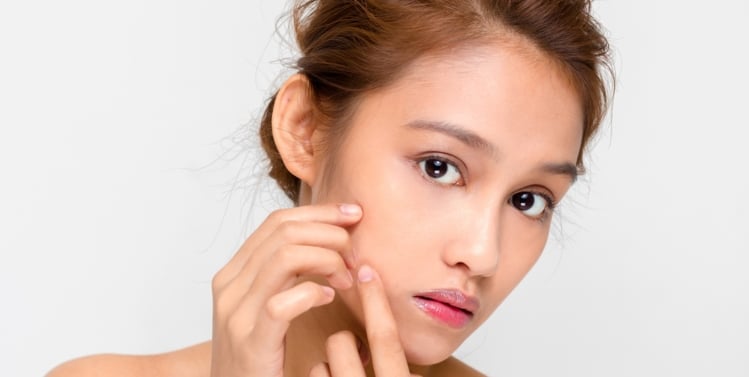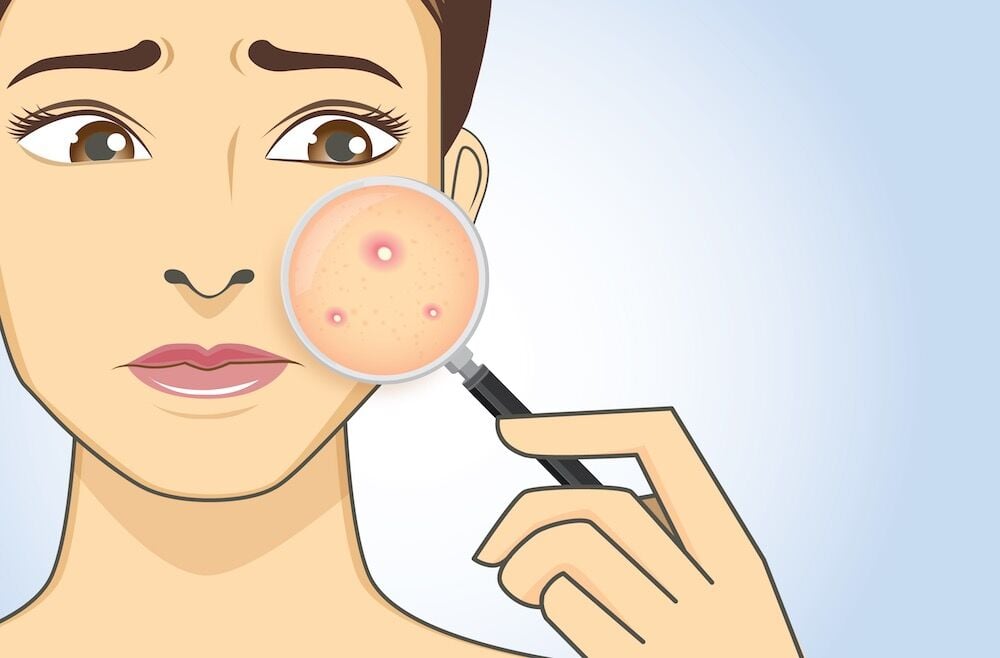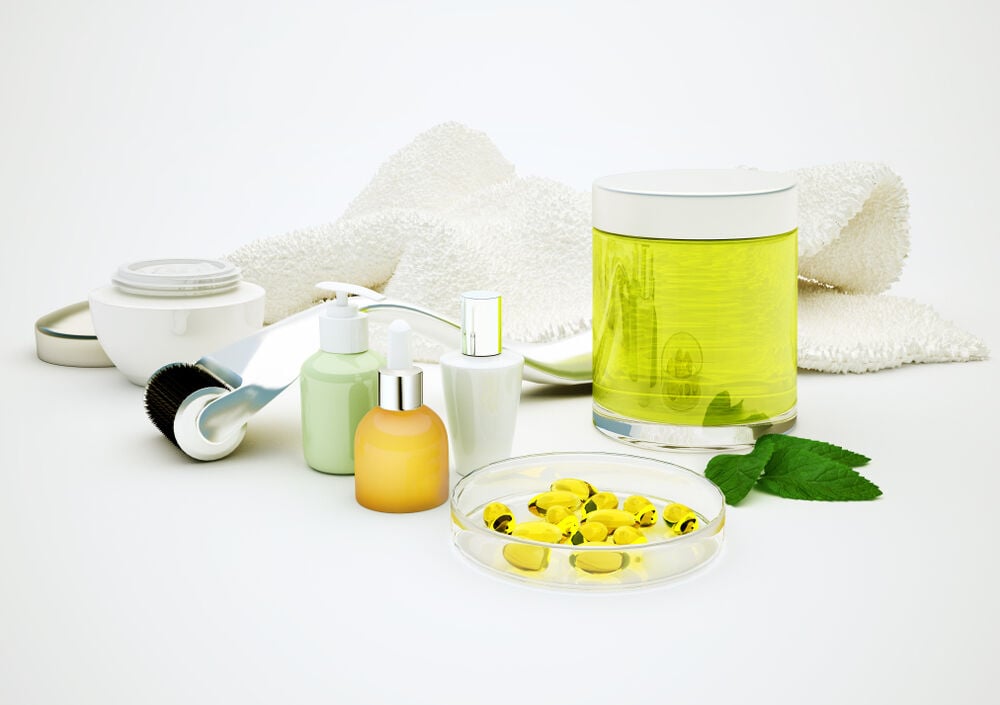There are many different things that can cause acne. This article will examine the causes, types, and treatment options for acne during your period.
-
Tracking cycle
-
Getting pregnant
-
Pregnancy
-
Help Center
-
Flo for Partners
-
Anonymous Mode
-
Flo app reviews
-
Flo Premium New
-
Secret Chats New
-
Symptom Checker New
-
Your cycle
-
Health 360°
-
Getting pregnant
-
Pregnancy
-
Being a mom
-
LGBTQ+
-
Quizzes
-
Ovulation calculator
-
hCG calculator
-
Pregnancy test calculator
-
Menstrual cycle calculator
-
Period calculator
-
Implantation calculator
-
Pregnancy weeks to months calculator
-
Pregnancy due date calculator
-
IVF and FET due date calculator
-
Due date calculator by ultrasound
-
Medical Affairs
-
Science & Research
-
Pass It On Project New
-
Privacy Portal
-
Press Center
-
Flo Accuracy
-
Careers
-
Contact Us
Period Acne: Causes, Types, and Treatment of Menstruation Acne

Every piece of content at Flo Health adheres to the highest editorial standards for language, style, and medical accuracy. To learn what we do to deliver the best health and lifestyle insights to you, check out our content review principles.
How the menstrual cycle influences acne
Several hormones in the body control the menstrual cycle. The average cycle lasts about 28 days, and on each one of those days, hormone levels can change. The changes the body goes through in the first half of the cycle are predominantly controlled by estrogen, and the second half is influenced by progesterone.
If there are acne flares one to two weeks before menstruation, if they go away with the onset of a period, and if this pattern repeats at least twice in a row, it may be because of premenstrual acne.
During this time, the ratio of estrogen and progesterone changes, which can affect the occurrence of acne breakouts. The drop in these hormones a few days before a period may also trigger acne flare-ups.
Symptoms of period acne
Period acne is different than the typical acne that occurs during other weeks of the menstrual cycle. Breakouts of pimples from period acne are usually on the lower half of the face (chin, cheeks), jawline, and neck. They are usually red, inflamed, raised bumps (papules) that rarely develop into pustules (papules with pus). They can be very frustrating, but try to resist squeezing them. This can make them worse and take longer to go away.

Changes in hormone levels may be one of the factors responsible for acne breakouts. Testosterone remains at a constant level during the whole menstrual cycle, while estrogen and progesterone drop as a period approaches. This means that before and during menstruation, testosterone levels may be higher than estrogen or progesterone.
The increased level of progesterone in the middle of the cycle stimulates the production of sebum. This natural oil can clog pores. This, along with additional factors, contributes to the formation of acne. The condition may worsen when testosterone levels are comparatively higher at the end of the menstrual cycle, which is right before the next period starts.
Acne lesions (tender bumps underneath the skin, or white or yellow spots) often appear before menstruation starts, mainly in hormone-dependent areas such as on the cheeks, in the lower third of the face, on the neck, and, less commonly, on the chest and back.
In these areas, enzymes convert free testosterone into a more potent androgen called dihydrotestosterone. As a result, the sebaceous glands become more active, and sebum can block hair follicles, leading to period acne.
Take a quiz
Find out what you can do with our Health Assistant
Is menopausal acne a form of hormonal acne?
Some people are surprised to learn that acne is one of the signs and symptoms of perimenopause. However, let’s stop here for a moment. Acne during your period is caused by changes in the sex hormones associated with the menstrual cycle, and approaching menopause, these same hormones make some drastic changes as well.
The term “menopause” simply means the ceasing of the menstrual cycle and consists of the 12 months following the final period. However, according to the National Institute on Aging, the time leading up to menopause (perimenopause) can last from 7 to 14 years. During this time, estrogen levels are dropping. This can cause hot flashes, sleeping difficulties, mood swings, and skin changes.
During perimenopause, estrogen levels in the body decline, but testosterone levels remain consistent. This shift in hormones combined with a decrease in skin cell regeneration can lead to clogged pores and can cause some people to experience acne for the first time in years. These outbreaks are usually located on the cheeks, chin, jawline, neck, and back.
If you are not at the typical age that most people experience symptoms of perimenopause (mid-40s) and are experiencing a sudden onset of severe acne, it may be due to a more serious health condition related to hormonal imbalance. These symptoms are usually not related to normal hormone changes during the menstrual cycle, so be sure to consult a health care provider.

Cystic acne during your period: What it is and how you can fight it
Cystic acne is a severe form of acne affecting the face, chest, and back. It is characterized by multiple inflamed lumps beneath the skin — nodules, cysts, and frequently, scars.
Acne is most common during the adolescent and teen years. However, acne can continue into adulthood and can be severe. According to recent studies, premenstrual acne in adults can be seen in 44 percent of women.
Cystic acne can occur as a result of the menstrual cycle as well as during other life events, such as pregnancy and perimenopause, because of hormonal changes.
Treatment can be challenging and may require a combination of medicines. Topical treatment is usually ineffective.
People with cystic acne often need additional treatments such as:
- Oral antibiotics
- Intralesional steroids
- Systemic steroids
- Hormonal therapy
One recommended treatment for cystic acne is an oral form of vitamin A. Make sure to speak to a health care provider before beginning to take any kind of supplements. The vitamin A treatment is required for at least five months, and further courses are sometimes necessary.
Others experience cystic acne because of genetics, or they may be acne prone. For these people, a more aggressive approach may be necessary with an oral form of vitamin A called isotretinoin. This is considered to be the best form of treatment for resistant cystic acne.
Isotretinoin works by targeting all the sources of cystic acne. It kills the acne-causing bacteria, unclogs pores, and decreases excess oil and inflammation. The course of treatment with this prescription medication usually takes four to five months and can have some serious side effects, particularly for women.
To take isotretinoin, it is necessary to take pregnancy tests before and while taking the medication, and to use at least one form of effective contraception to prevent pregnancy. Studies have shown that this medication is teratogenic, meaning it can cause developmental malformations (birth defects).
Period acne treatment
There are several different options available today to treat mild to moderate monthly breakouts. The more common treatments options include the following:
Topical creams, gels, ointments, and washes
For most people, mild acne can be treated with topical treatment (gels, solutions, and lotions).
These can be either over-the-counter (OTC) or by prescription. The most common OTC brands contain benzoyl peroxide or salicylic acid. There are more options available by prescription, typically prescribed by a dermatologist. They include:
- Azelaic acid — This medication kills bacteria and reduces inflammation. In addition, it has been found to significantly diminish the appearance of skin blemishes, help fade post-acne marks and other discolorations, refine the skin’s surface, and even skin tone.
- Antiseptic washes with benzoyl peroxide
- Mild salicylic acid preparations to exfoliate and unplug the follicles
- Topical retinoids — Made from vitamin A, retinoids promote new skin cell production to push oils and dead skin out of blocked pores. By doing this, it helps prevent blackheads and whiteheads.
- Topical and oral antibiotics — These acne medicines can kill some of the bacteria on the skin and reduce redness and inflammation. Topical antibiotics (e.g., erythromycin and clindamycin) are effective acne treatments but are not recommended for use on their own because of the risk of bacterial resistance.
Oral contraceptives
There are three variations of birth control pills that have been approved by the FDA for treating acne. All three are combined oral contraceptives that contain both estrogen and progesterone. In fact, progesterone-only birth control pills can make acne worse.
Treating acne can be a trial-and-error process to find the right one that works for you. This can be especially difficult when dealing with the continuous hormonal changes that occur throughout life.


Hey, I'm Anique
I started using Flo app to track my period and ovulation because we wanted to have a baby.


The Flo app helped me learn about my body and spot ovulation signs during our conception journey.


I vividly
remember the day
that we switched
Flo into
Pregnancy Mode — it was
such a special
moment.
Real stories, real results
Learn how the Flo app became an amazing cheerleader for us on our conception journey.




